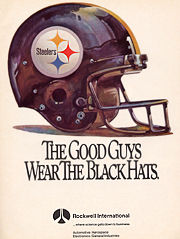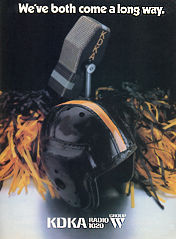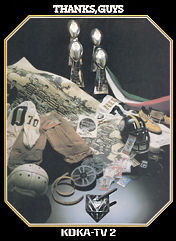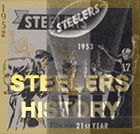ARTHUR
J. ROONEY
in 1983
Moments after the conclusion of Super Bowl IX, on a chilly January day in New Orleans eight years ago, captain Andy Russell held up a football in the Pittsburgh Steelers' locker room at old Tulane Stadium and handed it to an old man.
"This one's for the Chief," Russell said. "It's been a long time coming. " The Chief, Art Rooney, pulled out the old National Football League ledger books he keeps carefully wrapped in a cellophane bag in the desk drawer of his offices at Three Rivers Stadium. The books are 30 years old now, but they're still in remarkedly good condition.
They tell the story, in Rooney's own neat handwriting, of the birth of a franchise the humble origins of a team celebrating its Golden Anniversary season in 1982.
The 81-year-old Rooney opens the pages of the first ledger. It suggests football's equivalent of John Hancock's pulling the Declaration of Independence out of his desk drawer to show where he signed it. "I found these when we moved here. I don't think anybody around here is interested in them," Rooney says almost apologetically. "But they bring back a lot of memories for me."
He remembers Byron (Whizzer) White, Johnny Blood (McNally), and Bill Dudley as vividly as Terry Bradshaw, Franco Harris, and Lynn Swann. He remembers the bad old days as well as the good old days. He remembers he founded the team the year FDR became president, and didn't get his first championship trophy until Gerald Ford held the office.
He enjoyed all the years, even the frustrating ones when I had to walk in the alleys instead of on the main drag; but the most satisfying ones were when we finally won," he says.
The ledger books show it all started on September 20, 1933 - the Wednesday the Steelers played their first game at Forbes Field against, the New York Giants. There were 13,483 fans, who paid a total of $12,270.03. The Steelers lost 23-2, but Rooney noted: "Crowd was very enthusiastic." That was the modest beginning.
A whole generation of fans has grown up thinking the Steelers always were the modern, successful organisation that Rooney's two eldest sons, Dan and Art, Jr., and coach Chuck Noll built when they became the "Team of the Seventies."
But the game's pioneers never dreamed of instant relays and Super Sundays back in the days when they ran their franchises with a handshake. Rooney still remembers the time in the 1930s when George Halas of Chicago offered to give him $500 more than the guarantee for shifting a game date.
The guarantee was 40 percent of the gate or a minimum of $2,500. When it came time to divide the money, Rooney s 40 percent amounted to $3,200. After Rooney reminded Halas about the extra $500, Halas argued he already was getting $700 more than the $2,500 guarantee.
The two men argued their points back and forth until Halas got up from behind his desk and said, "I'll fight you for it, " Rooney laughed and said he didn't want to fight, but finally he won his argument and walked off with a check for $3,7 00.
As Rooney got to the door, he turned to Halas and said, "George, you know if we'd had that fight, you were no sure thing.
" It was just a hop, skip, I and a jump from semi-pro ball in those days, maybe just a hop," Rooney says between chomps on his familiar cigar. 'The biggest thrill wasn't in winning on Sunday but in meeting the payroll on Monday."
An athlete, a promoter, and a noted horse player, Rooney had been operating a semi-pro team for years. He was able to bring that team into the National Football League after paying a $2,300 NFL franchise fee in 1933 simply because the Pennsylvania Blue Laws banning Sunday play were repealed that year.
One of the most enduring legends is that he founded the team after scoring heavily at the racetrack. He did make a memorable two-day killing at old Empire City and Saratoga, but that came in 1936, after the franchise had been founded. The early days of the Steelers are rich in legend and lore.
Rooney's ledger entry after a 1934 game - "Pittsburgh looked bad, crowd hostile" - could have summed up a lot of games over the years. With a twinkle in his Irish eyes, Rooney, who seems to have stepped out of the pages of the Last Hurrah, tells stories about those days.
"I was at the track most of the time and, unfortunately, some of my coaches were with me," he says. Rooney's quick wit and easy- going manner have given him the image of being a loveable loser. He pleads innocent of the charge. "I take it terribly," he says. "Nobody feels any worse than I do about losing."
The Steelers didn't always lose. At times, they played better than legend now has it. Three different times - in 1936, 1947, and 1963 - the Steelers needed to win their last game to clinch the division title. On all three of those occasions they were playing a team they had beaten during the regular season. All three times, they lost.
That was the story of the franchise. Rooney often was operating on a shoestring budget because Forbes Field was a small stadium, and he was a good natured guy who never liked to make the tough decisions that go with a winning football team.
"My father was a little bit of a rogue and he had some flaws, but they were great flaws," his son Art, Jr., says. "He carried loyalty and friendship to the extreme." On top of everything else, the Steelers always seemed to be unlucky.
There were no Immaculate Receptions in those days. Instead, there were plays such as Frank Gifford's diving one-handed catch that helped the New York Giants beat the Steelers 33-17 in the 1963 finale for the division title.
The Steelers' coach in that game, Buddy Parker, once groaned, "When this team gets lucky, it'll be lucky for ten years." He didn't know he was looking ahead to the 1970s when Franco Harris made the Immaculate Reception and the Steelers won coin flips for the rights to draft Terry Bradshaw and Lynn Swann.
The team got new uniforms in 1941 and changed its name from Pirates to Steelers. When Art Rooney stopped at his team's Hershey, Pennsylvania, training camp to watch practice, a newsman asked what he thought of the team.
"They look like the same old Steelers," Rooney cracked.
The name stuck. For years and years, when anything went wrong, the fans derided them as the Same Old Steelers. Rooney's main project until the end of World War II simply was keeping the team alive.
The Steelers had only one winning season in their first 10 years. Even signing Whizzer White in 1938 for the then incredible sum of $13,800 didn't help. The team went 2-9 with the future U.S. Supreme Court Justice in the backfield.
In 1941, Rooney even sold the team to Alexis Thompson and bought half of the Philadelphia franchise owned by his friend Bert Bell. He quickly had second thoughts and convinced Thompson to swap teams.
So Rooney and Bell shared the Pittsburgh franchise during World War II. Bell retained his interest until 1946, when he became commissioner, and sold his share to Rooney and Barney McGinley, whose son Jack still owns 30 percent of the team.
After World War II, pro football took its first step towards big-time status. Rooney figured it was the beginning of a new era when he signed Dr. Jock Sutherland, who had won national collegiate championships at the University of Pittsburgh in the 1930s, as coach in 1946.
A tough disciplinarian, Sutherland had the Steelers in a playoff for the division title with Philadelphia in 1947. The Steelers lost 21-0, but Sutherland seemed to be building a winner. The franchise then was hit by tragedy. Sutherland died of a brain tumor in the spring of 1948.
The team floundered coaches John Michelosen, Joe Bach, and Walt Kiesling (who spent 21 years with the team and was called in to coach three different times).
Bach, who had coached the club in 1933-36 before leaving for various assistant and head coaching jobs at the collegiate level, modernised the team in 1952 when the Steelers became the last pro club to abandon the Single Wing. But Bach had to resign in 1934 because of illness.
It was an era noted for per- sonnel mistakes. The Steelers cut Johnny Unitas, a ninth round draft pick, in 1933. They made obscure defensive back Gary Click the number one pick in the 1936 draft. In 1937, they passed up Jim Brown for Len Dawson.
The Steelers had a sprinkling of good players, including Elbie Nickel, Ernie Stautner, Jim Finks, Lynn Chandnois, Jack Butler, Fran Rogel, and Pat Brady - but they really were the Same Old Steelers.
The only time Art Rooney ever interfered with a coach in his half century with the club came during the Kiesling regime. A conservative coach, Keisling sent Rogel up the middle on the first play of every game. The fans even chanted "Hi-Diddle-Diddle! Rogel Up the Middle. "
So Rooney finally ordered Kiesling to call a pass play on the first play of a game in 1956. It was such a surprise that Jack Scarhath threw an 80-yard touchdown pass to Jack (Goose) McClairen. But the play was called back because of an offside penalty, and on the next play, first and 15, Rogel went up the middle. Years later, Kiesling confessed to having told a player to intentionally beat the snap.
Buddy Parker's arrival in 1957 signaled the start an upswing in Steeler fortunes. The new coach brought in veterans such as Bobby Layne (his old Detroit quarterback), John Henry Johnson, and Eugene (Big Daddy) Lipscomb, and made the team a contender. But Parker was noted for his rash moves and impulsive trades - most notably the 1964 trade of wide receiver Buddy Dial to Dallas for the rights to defensive tackle Scott Appleton of Texas, whom the Steelers couldn't sign. It became known as the Buddy Dial- for-Nothing trade, another chapter of the Same Old Steelers.
After the Dial trade, there was a changing of the guard. Art Rooney told Buddy Parker to get approval for future trades from his eldest son, Dan. Born the year the team was founded, Dan was 31 and taking administrative control of the team.
Rooney's second son, Art, Jr., two years younger than Dan, was moving into the scouting department. A younger generation of Rooneys was coming of age. Art, Jr., known as Artie, says, "A friend of mine told me it wasn't for us. It was more like a quest in the days of the Knights, King Arthur and all that stuff. It was exciting to work in that climate. The family name was at stake."




